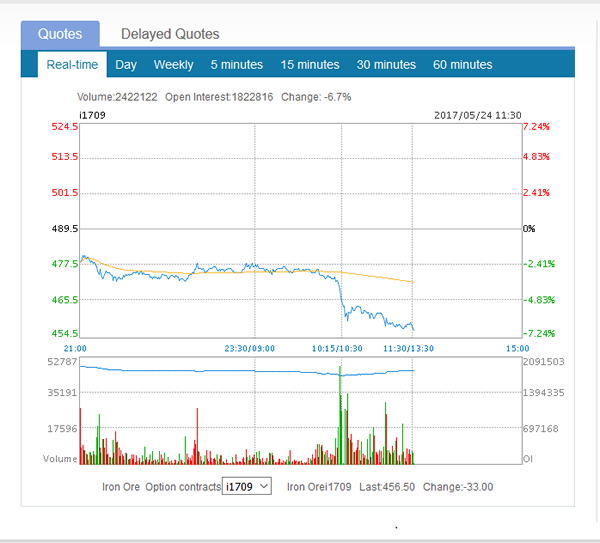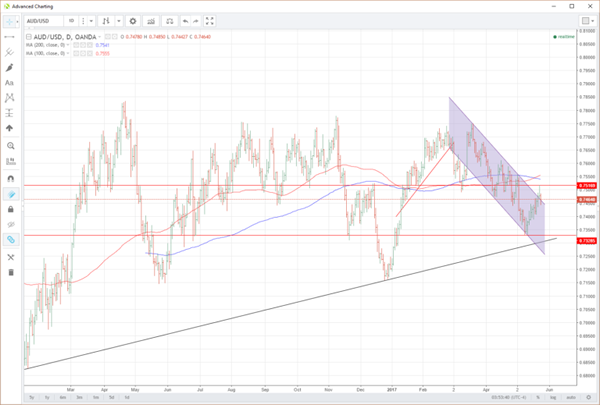A surprise sovereign downgrade of China by Moody’s sees iron ore collapse taking the Australian Dollar with it.
If ever there was a lesson about how intertwined the global economy is in the 21st century, it is the sometimes love/hate relationship between China and Australia. Both are mutually dependent on each other from a supply and demand point of view. In China’s case, they import just about everything that Australia digs out of its vast ground area to fuel their primary industries. Think coal, copper and most especially iron ore. For Australia, conversely, China is by far its largest trading partner. Consuming vast quantities of both various mineral ores as well as primary products such as meat and dairy to fuel the factory of the word. Given that China’s capital account can by no stretch of the imagination be considered open, despite the rhetoric, it can be very hard to express a trading view on the world’s 2nd largest economy. Both the onshore and offshore Chinese currencies, the CNY and the CNH, are carefully managed by the PBOC.
Given that China’s capital account can by no stretch of the imagination be considered open, despite the rhetoric, it can be very hard to express a trading view on the world’s 2nd largest economy. Both the onshore and offshore Chinese currencies, the CNY and the CNH, are carefully managed by the PBOC. The symbiotic nature of the Australian and Chinese relationship means that the Australian Dollar is a ‘high beta’ in financial market speak to developments within the Chinese economy. In plain English, this really means that because China’s capital account is closed, the Australian Dollar (AUD) is used to reflect developments in China.
One could say that when China is booking (read importing lots of raw materials), the AUD tends to move higher. Sometimes a lot higher. When China catches a cold(imports less raw materials), the AUD catches tuberculosis. Asia, including China, was thoroughly wrong-footed today when Moody’s rating agency surprisingly downgraded China’s sovereign debt from Aa3 to A1. It was the first downgrade of China by them since 1998.
08:18 *(CN) MOODY’S CUTS CHINA SOVEREIGN RATING TO A1 FROM AA3 (one notch); revises outlook from negative to stable (first Moody’s cut since 1989) Moody’s Investors Service has today downgraded China’s long-term local currency and foreign currency issuer ratings to A1 from Aa3 and changed the outlook to stable from negative. The downgrade reflects Moody’s expectation that China’s financial strength will erode somewhat over the coming years, with economy-wide debt continuing to rise as potential growth slows. – Source TradeTheNews.com
The markets wasted no time in China reacting to this with the Dalian Commodity Exchange Industrial MAtarial Futures all falling.
Both the coking coal and coke futures (used in steel and power production I believe) fell -1.80% and 2.70% respectively.
However, it was the Dalian iron Ore Futures that felt the fury, plunging 6.70% in a straight line as per the chart below.

AUD/USD
The AUD is for obvious reasons, sensitive to all three of the above commodities, but most especially to iron ore. It duly obliged in a ‘high beta’ fashion and fell in a straight line from 7480 to 7435 before making an anaemic recovery as the Asia session ended. Equities also felt the chill wind with the Shanghai Composite falling (-0.40%) along with the Hang Seng (-0.30%). Surprisingly the ASX 200 finished the day unchanged suggesting the effects of the downgrade may be transitory ahead of tonight’s FOMC minutes.
Looking at the chart below, we can see that AUD has fallen back into its down channel and is flirting with its upper boundary at 7460.
Resistance lies above here at yesterday’s high at 7517 before we encounter the important 7540/7455 region. Home to the 100 and 200-day moving averages.
Support lies at 7435 followed by the 9th May low at 7330. Long term support is denoted by a trendline stretching back to January 2016, which today is at 7305.

Summary
The China downgrade and subsequent fall in the iron ore futures indeed ‘ironed out’ the AUD today. However, the ASX closed flat, not a bad result when China iron ore futures dropped nearly seven percent. It may imply the AUD sell-off could be transitory unless we get a hawkish FOMC minutes this evening.












